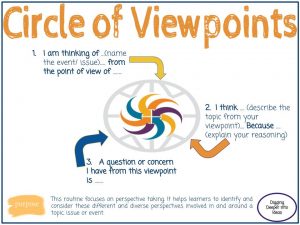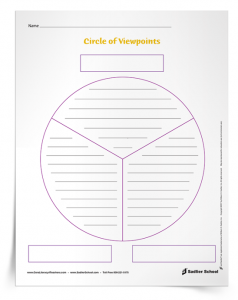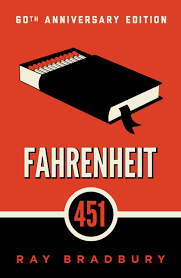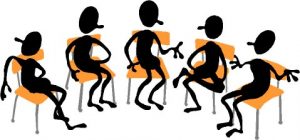Cooperative Learning Method 1: Circle of Viewpoints
For this idea, students are able to gain different viewpoints and perspectives from other classmates about a certain event, topic, or issue.This allows for a thorough and more complete understanding about what is being learned, as different students may offer information or think about the topic in different lights than others.
For example, a classroom might be asked what their first thoughts are when they see or hear the topic ‘Africa’. Each student would have the opportunity to think of what they think this topic is most associated with to them from what they have seen, heard, or read, including where Africa stands today on multiple bases, major figures that represent Africa as a nation, different cultures and languages commonly recognized, problems faced by the people who live there, and more.

During the activity, the compiled viewpoints can then be further explored. When having students explain their views before taking on another viewpoint to observe, the following prompts can be used to generate classroom/student discussion:
- I am thinking of ‘Africa’ from the point of view of…
- I think…because…
- A question/concern I have from this viewpoint is… (171).

Going along with the topic of Africa, one student might introduce the idea that Africa is culturally diverse. To approach this viewpoint, one might say that they are thinking about Africa from the point of view of it’s population/people. To explain their reasoning, one might say they think Africa is very culturally diverse given that they have seen statistics on the number of different cultures available within the continent. In response to that student, another student may respond to that idea with a concern or question about how that might affect neighboring groups of people who don’t share the same beliefs.
Cooperative learning structures would play out here as students would be able to build off of one another when coming together to share their different perspectives to create a more ‘whole’ way to view a topic, issue, or event and the ideas that are connected to it.
This type of learning method uses a ‘CO-OP CO-OP’ approach, where discussion is centered around students and are able to learn more about a unit/topic by expressing their ideas after brainstorming. This method also calls for record-keeping of student ideas before allowing them to share their thoughts, as stated in the lesson plan below:
Lesson Plan (Written Approach):
1. Approach the learning material to students by showing a story, explaining an issue or event, or simply introducing a topic and allow them to examine and consider where they stand and what other ideas it makes them think about. Writing the name of the topic also helps students to stay within that particular subject path.
Encourage students to ask questions, make observations, and really consider what they think and why. (As this is a written classroom activity, also make note to allow students to write their initial and concluding viewpoints for later discussion)
2. Compile and generate a large list of varying student viewpoints and ideas or even other related concepts or objects similar to the introduced topic. The list should be put together in a large circle to make things easier to see and bring all the topics together.
3. Ask the class which viewpoint they would like to explore the most and allow students to explain their thoughts on the topic.
4. Have students respond to the selected topic by letting them take on that particular viewpoint using the ‘I think…’ prompt based on what they have heard, seen, read, or interpreted. Have each student record their ideas down.
5. Have students respond to the ‘A question I have from this viewpoint…’ prompt and allow them to document their ideas.
6. Allow students to come together as a class to share their findings and different reasoning. Highlighting main and broad topic ideas for class discussion that has to do with difference in viewpoints between class members may be critical to dive into together for further contemplation and student thinking.
Practicing activities like such in the classroom encourages students to be more well-rounded and take on challenges individually while using multiple ways of thinking into how they work.
What I really like about this strategy is how students are brought together to discuss their divergent viewpoints where everyone will typically have a different perspective on the topic due to difference in culture or past experiences. This is very admirable in the way that learners can gather knowledge from other students based off of different cultural values that individuals possess as well as how all students think differently.
 To understand that students think and feel differently is essential to understand due to how it is a crucial aspect of the fairness ideal. From doing this activity, students are able to think of new ideas towards a subject from different perspectives as well as pose new questions that come to mind. For more information on this learning method and student examples of how this ‘circle’ could be filled out, this website dives into more detail. Other examples can also be found here under this pinterest link.
To understand that students think and feel differently is essential to understand due to how it is a crucial aspect of the fairness ideal. From doing this activity, students are able to think of new ideas towards a subject from different perspectives as well as pose new questions that come to mind. For more information on this learning method and student examples of how this ‘circle’ could be filled out, this website dives into more detail. Other examples can also be found here under this pinterest link.
Cooperative Learning Method 2: Sentence-Phrase-Word (207)
Using this method, students are engaged in rich discussions with another from reviewing a specific text. Students then choose a sentence that incited an emotion or an overall theme of the text, a phrase that provides engagement, and finally a word that is powerful to the individual. This idea allows individuals to create discussions with one another “while drawing attention to the power of language”(207).
For example, one book for students to look at could be Fahrenheit 451 by Ray Bradbury.  In this text, students can focus on a variety of different themes such as:
In this text, students can focus on a variety of different themes such as:
- Foreshadowing
- Censorship
- The Power of Knowledge
Students can look for different quotes or areas in the text where the respected theme is being expressed in the book along with their explanation of why it fits the theme. This type of learning method uses a group investigation approach, where students begin in small groups and each focus on a portion of the text individually before sharing what they chose and why. Afterwards, students can come together to discuss their thoughts as a class and analyze how the topics they came up with allows them to understand the text better.
Lesson Plan:
1. Provide students the selected text and give them some time to annotate the given piece to get a better understanding.
2. Once students are finished reading the piece, make sure that each person chooses a sentence that is most meaningful or powerful to them.
3. Gather students in groups from four to up to six people(varies on classroom size) and ask them to share and jot down their findings, and explain why they selected them. The first participant should share the sentence they chose, provide why he/she chose it, and allow others to comment and create discussions. Once the first student is done, the sentence they chose is recorded, and then the following student starts to share, record, and starts speaking until everyone in the group shares his or her own sentence. By doing this, the group discussion flows smoothly. Students should each share their thoughts in order to prevent any one student from becoming the ‘dominant’ spokesperson in any group and to let everyone have a fair and equal opportunity to share. To ensure this, it is best that the teacher go around and listen to student’s ideas and monitor how groups perform with each other.

4. After students share, each group analyzes all of the responses. Student should identify the common themes derived from responses as well as the predictions they suggested. Finally, the group should identify any areas of the piece that were not provided in their own choice of sentence, phrases, and words.
5. Lastly, posting all groups documents up. It is essential to provide time for students to look at the sentences, phrases, and words that they chose and all of the implications that were drawn from them. Then, each group member should be able to briefly reflect on their understanding of the specific text and how this routine helped contribute with their understanding before coming together as a class to share their thoughts as a whole.

Using strategies like the Sentence-Phrase-Word encourages students to engage with one another when going over a specific text. This routine enables students to “capture the essence of the text”(207). What I love about this strategy is that it allows students to be able to discuss with one another while slowly realizing how powerful language is when breaking down pieces of text to one word.
For more information on this method, please refer to this pdf file where this classroom activity is further discussed, or this video where this method is being performed!
